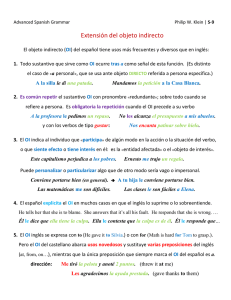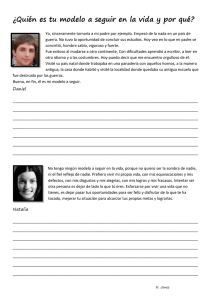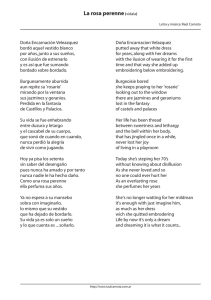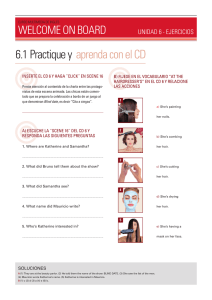Reading Connection Nov. Newsletter - Grades K
Anuncio
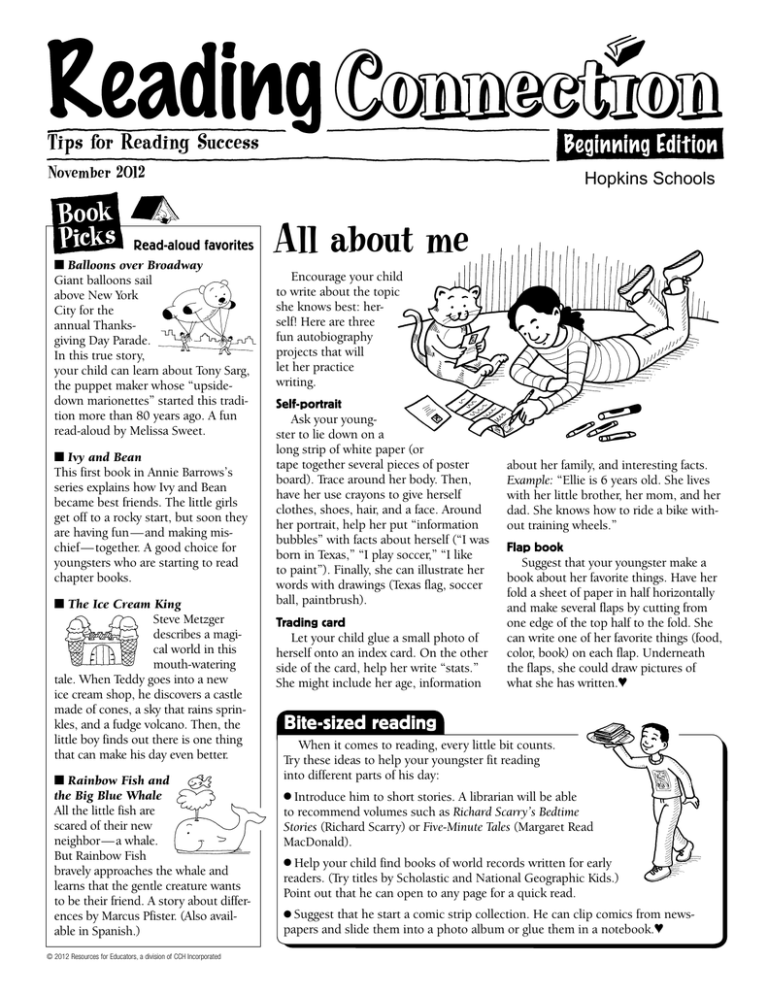
!"#$%&'(%)*+,"-.%/011*$$% 2'3*45*(%6786% Read-aloud favorites ■ Balloons over Broadway Giant balloons sail above New York City for the annual Thanksgiving Day Parade. In this true story, your child can learn about Tony Sarg, the puppet maker whose “upsidedown marionettes” started this tradition more than 80 years ago. A fun read-aloud by Melissa Sweet. ■ Ivy and Bean This first book in Annie Barrows’s series explains how Ivy and Bean became best friends. The little girls get off to a rocky start, but soon they are having fun —and making mischief —together. A good choice for youngsters who are starting to read chapter books. ■ The Ice Cream King Steve Metzger describes a magical world in this mouth-watering tale. When Teddy goes into a new ice cream shop, he discovers a castle made of cones, a sky that rains sprinkles, and a fudge volcano. Then, the little boy finds out there is one thing that can make his day even better. ■ Rainbow Fish and the Big Blue Whale All the little fish are scared of their new neighbor—a whale. But Rainbow Fish bravely approaches the whale and learns that the gentle creature wants to be their friend. A story about differences by Marcus Pfister. (Also available in Spanish.) © 2012 Resources for Educators, a division of CCH Incorporated +RSNLQV6FKRROV 9::%+5'0;%4*% Encourage your child to write about the topic she knows best: herself! Here are three fun autobiography projects that will let her practice writing. Self-portrait Ask your youngster to lie down on a long strip of white paper (or tape together several pieces of poster board). Trace around her body. Then, have her use crayons to give herself clothes, shoes, hair, and a face. Around her portrait, help her put “information bubbles” with facts about herself (“I was born in Texas,” “I play soccer,” “I like to paint”). Finally, she can illustrate her words with drawings (Texas flag, soccer ball, paintbrush). Trading card Let your child glue a small photo of herself onto an index card. On the other side of the card, help her write “stats.” She might include her age, information about her family, and interesting facts. Example: “Ellie is 6 years old. She lives with her little brother, her mom, and her dad. She knows how to ride a bike without training wheels.” Flap book Suggest that your youngster make a book about her favorite things. Have her fold a sheet of paper in half horizontally and make several flaps by cutting from one edge of the top half to the fold. She can write one of her favorite things (food, color, book) on each flap. Underneath the flaps, she could draw pictures of what she has written.♥ Bite-sized reading w When it comes to reading, every little bit counts. Try these ideas to help your youngster fit reading into different parts of his day: ● Introduce him to short stories. A librarian will be able to recommend volumes such as Richard Scarry’s Bedtime Stories (Richard Scarry) or Five-Minute Tales (Margaret Read MacDonald). ● Help your child find books of world records written for early readers. (Try titles by Scholastic and National Geographic Kids.) Point out that he can open to any page for a quick read. ● Suggest that he start a comic strip collection. He can clip comics from newspapers and slide them into a photo album or glue them in a notebook.♥ 2'3*45*(%6786%<%=+.*%6 /#';%;>*%,*;+":$ Duke. He might think, “What tools do archaeologists use?” or “What are fossils?” Help him read the book, and see how many answers he can find. What is an archaeologist? What do bears eat? Nonfiction books have the answers—and if your child reads carefully, he will find them. The following suggestions can help him read for details and boost his comprehension. Read around the text. The pages of many nonfiction books are covered with “extras” that stories don’t have (headings, photo captions, an index, a glossary). Point out these features. Then, ask your youngster what questions he has about the topic that the book might answer. Say he’s reading Archaeologists Dig for Clues by Kate %% Sorting for sounds This colorful word collage will help your child learn about phonics, or the link between letters and sounds. Save cardboard food packages like cereal boxes and cracker boxes. Then, help your youngster cut out at least a dozen words, and read the words aloud with her. Suggest that she choose a few that have something in common and glue them on a piece of paper. For example, a younger child could pick cheese, chocolate, and cheddar because they all start with a ch sound. An older child might choose vitamin, iron, and icing because they all have a “long i” sound. Let her display her collages on the refrigerator or pantry door. She can add to them by cutting words from more boxes.♥ O U R P U R P O S E To provide busy parents with practical ways to promote their children’s reading, writing, and language skills. Resources for Educators, a division of CCH Incorporated 128 N. Royal Avenue • Front Royal, VA 22630 540-636-4280 • [email protected] www.rfeonline.com ISSN 1540-5648 © 2012 Resources for Educators, a division of CCH Incorporated Pair fiction with nonfiction. Together, read a story like Goldilocks and the Three Bears (James Marshall) followed by a nonfiction book such as Bears (Deborah Hodge). As you read the second book, encourage your child to look for ways that real bears are different from the fictional ones. For example, he might say that real bears eat things like grass, berries, fish, and insects, while the three bears eat porridge.♥ Alphabet fun My daughter is learning the alphabet in school. What games can we play at home that will help her? Many games that you already play can help your daughter practice her ABCs. If you have Twister, turn it into Alphabet Twister by using masking tape to make a different letter on each circle. To play, spin the spinner and call out the directions and a letter that’s on the color you spun (“Left hand on C”). If you don’t have Twister, let your daughter draw colored circles on an old sheet and write letters inside the circles. Also, look for household games that include letter tiles. You might hide the tiles in her sandbox or make “alphabet soup” by burying them in a bowl of uncooked rice. Encourage her to use a small plastic shovel or a pair of kitchen tongs to dig up the hidden letters. She can name each one that she finds. When she has them all, have her put them in order and point to them while she sings the alphabet song.♥ Story-starter bank Sometimes after I finish reading to my son Trevor, he wants to write his own story. It happened at bedtime recently — we read Ginger by Charlotte Voake, and he asked to write about his cats. I suggested that Trevor write down his idea so he’d remember it the next day. In the morning, he said he had thought of more story ideas while he was falling asleep. So I taped a sign that read “Story Starters” to an old cookie jar. I encouraged Trevor to cut “cookies” out of brown construction paper, write his ideas on them, and add them to the jar. He came up with things like “Fishing with Daddy” and “Raking the Leaves.” He also put a stack of blank cookies beside the jar and stored a few in the car for when he comes up with ideas away from home. Trevor’s jar is filling up quickly! Now when he wants to write a story, he pulls out an idea and gets to work.♥ !"#$%&'$($&)(*+,-$(&#,&.$&.#/)+($ 012*#34(#&"#&5675 Para leer en voz alta ■ Balloons over Broadway Unos gigantescos globos vuelan sobre Nueva York en el desfile anual del Día de Acción de Gracias. En esta verídica historia su hija conocerá a Tony Sarg, el fabricante de marionetas que inició esta tradición hace más de 80 años. Una divertida narración para leer en voz alta de Melissa Sweet. ■ Ivy and Bean El primer libro de la serie de Annie Barrows explica cómo Ivy y Bean se hicieron amigas íntimas. Las niñas empiezan con dificultades pero en seguida se divierten —y hacen travesuras—juntas. Una buena opción para los pequeños que comienzan a leer libros con capítulos. ■ The Ice Cream King Steve Metzger describe un mundo mágico en esta apetitosa historia. Cuando Teddy entra en la nueva heladería descubre un castillo hecho de cucuruchos, un cielo del que cae lluvia de dulces y un volcán de chocolate fundido. Luego Teddy descubre que hay una cosa que todavía puede mejorar su día. ■ Rainbow Fish and the Big Blue Whale Los pececillos tienen miedo de su nueva vecina, una ballena. Pero Pez Arcoíris se acerca a la ballena y averigua que el gentil animal quiere ser su amigo. Una narración sobre la diferencia de Marcus Pfister. (Disponible en español.) © 2012 Resources for Educators, a division of CCH Incorporated +RSNLQV6FKRROV 81"1&%14(#&39 Anime a su hija a que escriba sobre el tema que mejor conoce: ¡Ella misma! He aquí tres amenos proyectos autobiográficos con los que practicará la escritura. Autorretrato Dígale a su hija que se tumbe en una tira larga de papel blanco (o que pegue varios trozos de cartulina). Trace el contorno de su cuerpo. A continuación, que ella use crayones para añadir ropa, zapatos, pelo y una cara. Ayúdela a que alrededor de su retrato ponga “burbujas de información” con datos sobre sí misma (“Nací en Texas”, “Juego al fútbol”, “Me gusta pintar”). Finalmente puede ilustrar sus palabras con dibujos (bandera de Texas, balón de fútbol, pincel). Naipes de intercambio Que su hija pegue una foto pequeña de sí misma en una ficha de cartulina. En el reverso de la ficha ayúdela a que escriba “datos estadísticos”. Podría incluir su edad, información sobre su familia y datos interesantes. Ejemplo: “Elle tiene 6 años. Vive con su hermanito, su mamá y su papá. Sabe montar en bicicleta sin ruedas de entrenamiento”. Libro de solapas Sugiérale a su hija que haga un libro sobre sus cosas favoritas. Dígale que doble un folio de papel por la mitad en sentido horizontal y que corte varias solapas haciendo un corte desde un extremo de la mitad superior hasta el doblez. Puede escribir una de sus cosas favoritas (comida, color, libro) en cada solapa. Debajo de las solapas podría dibujar lo que ha escrito.♥ Bocaditos de lectura w En lo relativo a la lectura, cada poquito cuenta. Ponga a prueba estas ideas para ayudar a su hijo a integrar la lectura en las distintas partes de su día: ● Inícielo en el mundo de los relatos breves. Una bibliotecaria puede recomendarles volúmenes como Richard Scarry’s Bedtime Stories (Richard Scarry) o Five-Minute Tales (Margaret Read MacDonald). ● Ayude a su hijo a que busque libros de récords mundiales escritos para lectores principiantes. (Prueben con los títulos de Scholastic y National Geographic Kids.) Indíquele que puede abrir cualquier página para una lectura rápida. ● Sugiérale que empiece una colección de tiras cómicas. Puede recortar cómics de periódicos y meterlos en un álbum de fotos o pegarlos en un cuaderno.♥ 012*#34(#&"#&5675&:&;<=*,$&5 >,/+#,)($&.1%&"#)$..#% que está leyendo Archaeologists Dig for Clues de Kate Duke. Podría pensar: “¿Qué herramientas usan los arqueólogos?” o “¿Qué son fósiles?” Lea con él el libro y vean cuántas respuestas puede encontrar. ¿Qué es un arqueólogo? ¿Qué comen los osos? Los libros que no son ficción contienen las respuestas y si su hijo los lee con cuidado puede encontrarlas. Las siguientes sugerencias pueden ayudarle a leer en busca de detalles y a reforzar la comprensión de lectura. Leer alrededor del texto. Las páginas de muchos libros que no son ficción están cubiertas de “extras” que no aparecen en los cuentos (encabezamientos, pies de foto, índice, glosario). Observen estos rasgos. Pregunte a su hijo qué cuestiones se le ocurren sobre el tema cuya respuesta podría hallarse en las páginas del libro. Digamos Ordenar los sonidos & Este vistoso collage enseñará a su hija fonética, es decir, la relación que existe entre letras y sonidos. Guarde paquetes de comida como cajas de cereales y cajas de galletas. Ayude a su hija a recortar por lo menos doce palabras y lea las palabras en voz alta con ella. Sugiérale que elija unas cuantas que tengan algo en común y las pegue en un papel. Por ejemplo, una niña pequeña podría elegir charla, chocolate y chaqueta porque empiezan con el sonido ch. Si juegan en inglés, una niña algo mayor podría elegir vitamin, iron y icing porque todas esas palabras tienen un sonido de “i larga”. Que su hija exhiba sus collages en la nevera o la puerta de la nevera. Puede añadir más piezas recortando palabras de más cajas.♥ N U E S T R A F I N A L I D A D Proporcionar a los padres atareados ideas prácticas que promuevan la lectura, la escritura y la expresión oral de sus hijos. Resources for Educators, una filial de CCH Incorporated 128 N. Royal Avenue • Front Royal, VA 22630 540-636-4280 • [email protected] www.rfeonline.com ISSN 1540-5656 © 2012 Resources for Educators, a division of CCH Incorporated Emparejar ficción y no ficción. Lean un cuento como Ricitos de Oro y los Tres Osos (James Marshall) y a continuación un libro de no ficción como Bears (Deborah Hodge). Cuando lean el segundo libro, anime a su hijo a que descubra cómo los osos de verdad son distintos de los de ficción. Por ejemplo, podría decir que los osos de verdad comen cosas como hierba, bayas, peces e insectos mientras que los tres ositos comen gachas de avena.♥ Divertido abecedario Mi hija está aprendiendo el abecedario en la escuela. ¿Qué juegos podemos jugar en casa que le ayuden a aprenderlo? Muchos juegos a los que ya juegan pueden ayudar a su hija a practicar el abecedario. Si tienen Twister, conviértalo en Twister del Abecedario usando cinta de pintor para hacer una letra distinta en cada círculo. Para jugar, giren el rotatorio y digan las instrucciones y una letra que esté en el color al que apuntaron (“Mano izquierda en C”). Si no tienen Twister, que su hija haga círculos de colores en una sábana vieja y escriba letras en los círculos. Busquen también juegos para la casa que incluyan baldosines con letras. Podrían esconder las baldosas en su arenero o hacer “sopa de letras” enterrándolas en un tazón de arroz crudo. Dígale que use una palita de plástico o un par de pinzas de cocina para desenterrar las letras enterradas. Puede decir el nombre de cada letra cuando la encuentre. Cuando las tenga todas, dígale que las coloque en orden y señálelas cuando ella cante la canción del abecedario.♥ Banco de comienzos A veces cuando termino de leerle a mi hijo Trevor, él quiere escribir su propio cuento. Sucedió hace poco a la hora de acostarse: leíamos Ginger de Charlotte Voake y dijo que quería escribir sobre sus gatos. Le sugerí a Trevor que anotara la idea para recordarla el día siguiente. Por la mañana me dijo que se le habían ocurrido otras cuantas ideas mientras se dormía. Pegué las palabras “Comienzos de historias” en un viejo tarro para galletas. Animé a Trevor a que cortara “galletas” con cartulina marrón, escribiera sus ideas en ellas y las metiera en el tarro. Se le ocurrieron cosas como “De pesca con papá” y “Rastrillar las hojas”. También puso un montoncito de galletas en blanco junto al tarro y guardó unas cuantas en el auto para cuando le vengan ideas y no estemos en casa. El frasco de Trevor se va llenando rápidamente. Ahora, cuando quiere escribir una historia, saca una idea y se pone a trabajar.♥
